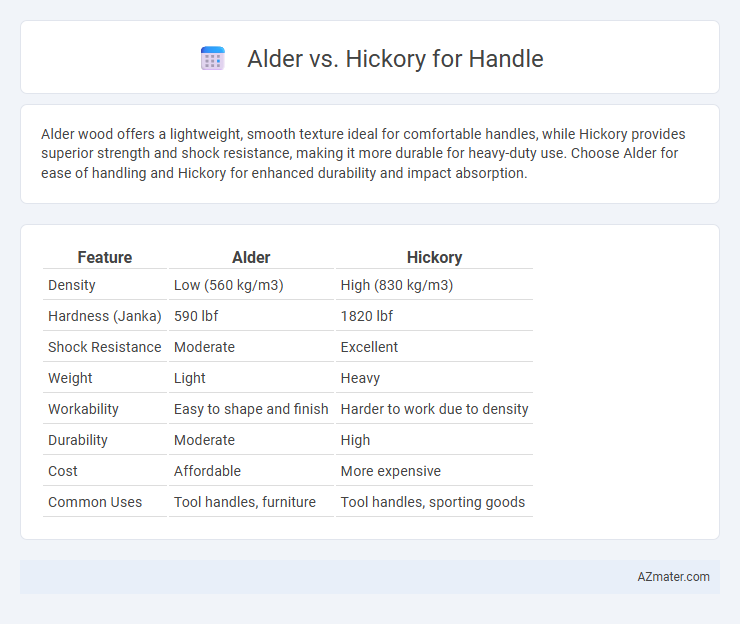Alder wood offers a lightweight, smooth texture ideal for comfortable handles, while Hickory provides superior strength and shock resistance, making it more durable for heavy-duty use. Choose Alder for ease of handling and Hickory for enhanced durability and impact absorption.
Table of Comparison
| Feature | Alder | Hickory |
|---|---|---|
| Density | Low (560 kg/m3) | High (830 kg/m3) |
| Hardness (Janka) | 590 lbf | 1820 lbf |
| Shock Resistance | Moderate | Excellent |
| Weight | Light | Heavy |
| Workability | Easy to shape and finish | Harder to work due to density |
| Durability | Moderate | High |
| Cost | Affordable | More expensive |
| Common Uses | Tool handles, furniture | Tool handles, sporting goods |
Introduction to Alder and Hickory Wood
Alder wood is a lightweight hardwood known for its fine, even grain and smooth texture, making it a popular choice for tool handles and woodworking projects requiring a soft yet durable material. Hickory wood is a dense, strong hardwood with excellent shock resistance, commonly used for tool handles due to its toughness and ability to absorb impact without breaking. Comparing the two, alder offers ease of shaping and a lighter feel, while hickory provides superior strength and durability for heavy-duty applications.
Key Characteristics of Alder Handles
Alder handles are prized for their lightweight nature and smooth texture, providing excellent grip and comfort in tool and furniture applications. The wood's fine, uniform grain allows for easy shaping and a consistent finish, making alder handles highly durable and resistant to wear. Compared to hickory, alder offers less density and shock resistance but excels in versatility and ease of customization.
Key Characteristics of Hickory Handles
Hickory handles are renowned for their exceptional strength, shock resistance, and durability, making them ideal for demanding hand tools and sports equipment. The dense grain structure and natural flexibility of hickory provide superior impact absorption and reduce user fatigue. These key characteristics ensure long-lasting performance and a secure, comfortable grip compared to softer wood like alder.
Strength and Durability Comparison
Hickory handles exhibit superior strength and durability compared to alder, making them ideal for heavy-duty tools and equipment requiring high impact resistance. The dense, tight grain structure of hickory provides excellent shock absorption and wear resistance, extending the lifespan of handles under strenuous use. Alder, while lighter and more flexible, lacks the robustness of hickory and is better suited for applications where weight reduction is prioritized over maximum strength.
Weight and Balance Differences
Alder handles are typically lighter than hickory handles, contributing to overall reduced tool weight, which enhances ease of use and minimizes fatigue during extended tasks. Hickory offers superior density and strength, providing better balance and shock absorption, making it ideal for heavy-duty tools where control and durability are essential. The weight difference between alder and hickory directly affects the tool's swing dynamics, with hickory handles delivering a more solid, well-balanced feel compared to the lighter, more agile characteristic of alder.
Shock Absorption: Alder vs Hickory
Hickory handles exhibit superior shock absorption compared to alder, making them ideal for tools subjected to repeated impact and vibrations. The dense grain structure of hickory fibers dissipates energy efficiently, reducing user fatigue during extended use. Alder, while lighter and smoother, lacks the resilience needed for high-impact shock absorption, favoring comfort over durability.
Workability and Shaping Ease
Alder wood offers excellent workability and ease of shaping due to its softer texture and consistent grain, making it ideal for finely detailed handle designs. Hickory, while tougher and denser, provides outstanding durability but requires more effort and sharper tools for precision shaping. Choosing Alder enhances efficiency in crafting smooth, ergonomic handles, whereas Hickory is preferred for rugged, impact-resistant handles despite its shaping challenges.
Cost and Availability Factors
Hickory handles typically cost more than alder due to the wood's superior durability and shock resistance, making it a preferred choice for heavy-use tools like axes and hammers. Alder wood is more widely available and budget-friendly, commonly used for handles in less demanding applications or where cost constraints are significant. Availability varies regionally, with hickory primarily sourced from the eastern United States and alder found abundantly in the Pacific Northwest, impacting shipping costs and lead times.
Best Uses for Each Wood Type
Alder wood, characterized by its lightweight and smooth grain, excels for tool handles requiring moderate strength and comfort, such as paintbrushes and light hand tools. Hickory, known for its exceptional density, shock resistance, and durability, is ideal for heavy-duty handles like axes, hammers, and baseball bats where impact absorption is crucial. Choosing between alder and hickory depends on the handle's intended stress level and ergonomic needs, with hickory preferred for toughness and alder suited for lighter, detailed work.
Final Verdict: Choosing the Right Handle Material
Alder offers a lightweight, smooth grain ideal for ergonomic handles, while Hickory provides exceptional strength and shock resistance, making it suitable for heavy-duty use. The final verdict depends on application: Alder is preferred for comfort and aesthetic versatility in tools or utensils, whereas Hickory excels in durability for impact-prone handles. Selecting the right handle material hinges on balancing the need for comfort against the requirement for toughness in the intended use.

Infographic: Alder vs Hickory for Handle
 azmater.com
azmater.com